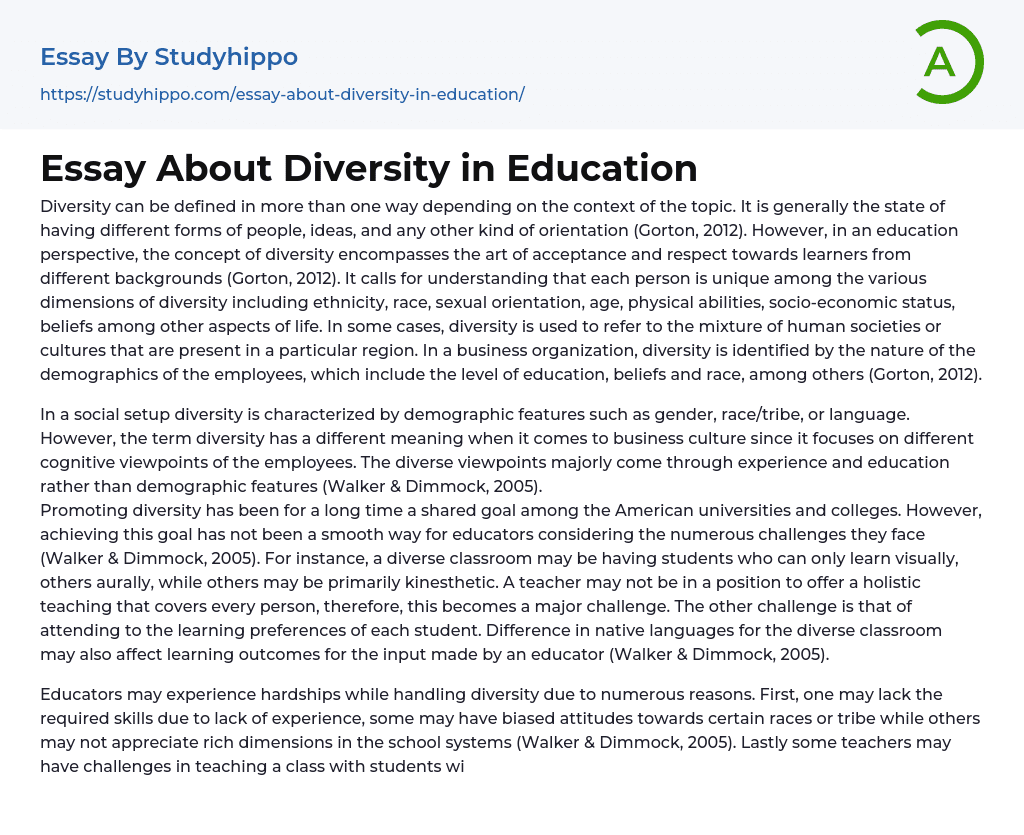Diversity can be defined in more than one way depending on the context of the topic. It is generally the state of having different forms of people, ideas, and any other kind of orientation (Gorton, 2012). However, in an education perspective, the concept of diversity encompasses the art of acceptance and respect towards learners from different backgrounds (Gorton, 2012). It calls for understanding that each person is unique among the various dimensions of diversity including ethnicity, race, sexual orientation, age, physical abilities, socio-economic status, beliefs among other aspects of life. In some cases, diversity is used to refer to the mixture of human societies or cultures that are present in a particular region. In a business organization, diversity is identified by the nature of the demographics of the employees, which include the level of education, beliefs and race, among other
...s (Gorton, 2012).
In a social setup diversity is characterized by demographic features such as gender, race/tribe, or language. However, the term diversity has a different meaning when it comes to business culture since it focuses on different cognitive viewpoints of the employees. The diverse viewpoints majorly come through experience and education rather than demographic features (Walker & Dimmock, 2005).
Promoting diversity has been for a long time a shared goal among the American universities and colleges. However, achieving this goal has not been a smooth way for educators considering the numerous challenges they face (Walker & Dimmock, 2005). For instance, a diverse classroom may be having students who can only learn visually, others aurally, while others may be primarily kinesthetic. A teacher may not be in a position to offer a holistic teaching that covers every person
therefore, this becomes a major challenge. The other challenge is that of attending to the learning preferences of each student. Difference in native languages for the diverse classroom may also affect learning outcomes for the input made by an educator (Walker & Dimmock, 2005).
Educators may experience hardships while handling diversity due to numerous reasons. First, one may lack the required skills due to lack of experience, some may have biased attitudes towards certain races or tribe while others may not appreciate rich dimensions in the school systems (Walker & Dimmock, 2005). Lastly some teachers may have challenges in teaching a class with students with special needs such as the deaf, the blind and the dumb. This is because they require specialized skills which may not be familiar to the teacher.
References
- Gorton R. A., (2012). School Leadership and Administration: Important Concepts, Case Studies, and Simulations, (9th Ed), ISBN-13 9780078110269.
- Walker, A. and Dimmock, (2005). Educational Leadership: Beyond Culture and Diversity, Sage Publications ISBN- 9780761971702.
- Academia essays
- Academic And Career Goals essays
- Academic Integrity essays
- Brainstorming essays
- Brown V Board of Education essays
- Brown Vs Board Of Education essays
- Coursework essays
- Curriculum essays
- Distance learning essays
- Early Childhood Education essays
- Education System essays
- Educational Goals essays
- First Day of School essays
- Higher Education essays
- Importance Of College Education essays
- Importance of Education essays
- Language Learning essays
- Online Education Vs Traditional Education essays
- Pedagogy essays
- Philosophy of Education essays
- Purpose of Education essays
- Scholarship essays
- Study essays
- Studying Abroad essays
- Studying Business essays
- Technology in Education essays
- The Importance Of Higher Education essays
- Vocabulary essays
- Writing Experience essays




